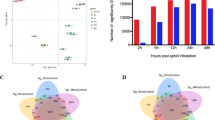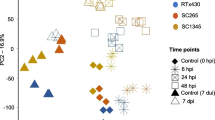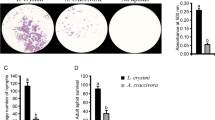Abstract
Pea aphids (Acyrthosiphon pisum) are one of the most important insect pests of alfalfa (Medicago sativa). Arbuscular mycorrhizal (AM) fungi are important microorganisms of the agroecosystem that promote plant growth and improve plant resistance to abiotic and biotic stress. Little information is available on AM fungi-regulated defense responses of alfalfa to pea aphids. To better understand how alfalfa responds and to evaluate the impact of an AM fungus on aphid infestation, transcriptome sequencing was done and physiological parameters were analyzed. Our experiments showed that Rhizophagus intraradices can regulate plant response to aphids by promoting growth and increasing plant peroxidase (POD) and catalase (CAT) activities and salicylic acid (SA) concentration after aphid infestation. Transcriptome analysis showed that R. intraradices increased the expression of resistance-related genes, such as “WRKY transcription factor” and “Kunitz trypsin inhibitor.” Additionally, GO terms “chitinase activity,” “peroxidase activity,” “defense response,” and “response to biotic stimulus,” and KEGG pathways “phenylpropanoid biosynthesis” and “phenylalanine metabolism” were significantly enriched in mycorrhizal fungus-inoculated plants and aphid-infested plants. These findings will improve our understanding about the impact of this AM fungus on alfalfa response to aphid feeding and will provide the basis for further research on plant defense against aphids.





Similar content being viewed by others
References
Anders S, Huber W (2010) Differential expression analysis for sequence count data. Genome Biol 11(10):R106
Ashburner M, Ball CA, Blake JA, Botstein D, Butler H, Cherry JM, Davis AP, Dolinski K, Dwight SS, Eppig JT, Harris MA, Hill DP, Issel-Tarver L, Kasarskis A, Lewis S, Matese JC, Richardson JE, Ringwald M, Rubin GM, Sherlock G (2000) Gene Ontology: tool for the unification of biology. Nat Genet 25(1):25–29
Atamian HS, Eulgem T (2012) SlWRKY70 is required for Mi-1-mediated resistance to aphids and nematodes in tomato. Planta 235(2):299–309
Babikova Z, Gilbert L, Bruce TJA, Birkett M, Caulfield JC, Woodcock C, Pickett JA, Johnson D (2013) Underground signals carried through common mycelial networks warn neighbouring plants of aphid attack. Ecol Lett 16(6):835–843
Bailly C, Benamar A, Corbineau F, Come D (1996) Changes in malondialdehyde content and in superoxide dismutase, catalase and glutathione reductase activities in sunflower seeds as related to deterioration during accelerated aging. Physiol Plantarum 97(1):104–110
Balestrini R, Salvioli A, Dal Molin A, Novero M, Gabelli G, Paparelli E, Marroni F, Bonfante P (2017) Impact of an arbuscular mycorrhizal fungus versus a mixed microbial inoculum on the transcriptome reprogramming of grapevine roots. Mycorrhiza 27(5):417–430
Bastías DA, Alejandra M-GM, Newman JA, Card SD, Mace WJ, Gundel PE (2017) The plant hormone salicylic acid interacts with the mechanism of anti-herbivory conferred by fungal endophytes in grasses. Plant Cell Environ 41(2)
Brault V, Uzest M, Monsion B, Jacquot E, Blanc S (2010) Aphids as transport devices for plant viruses. C R Biol 333(6):524–538
Chen W, Li J, Zhu H, Xu P, Chen J, Yao Q (2017) Arbuscular mycorrhizal fungus enhances lateral root formation in Poncirus trifoliata (L.) as revealed by RNA-Seq analysis. Front Plant Sci 8:2039
Ding X, Gopalakrishnan B, Johnson LB, White FF, Wang X, Morgan TD, Kramer KJ, Muthukrishnan S (1998) Insect resistance of transgenic tobacco expressing an insect chitinase gene. Transgenic Res 7(2):77–84
Ding W, Fang W, Shi S, Zhao Y, Li X, Xiao K (2016) Wheat WRKY type transcription factor gene TaWRKY1 is essential in mediating drought tolerance associated with an ABA-dependent pathway. Plant Mol Bio Rep 34(6):1–16
Dixon RA, Paiva NL (1995) Stress-Induced Phenylpropanoid Metabolism. Plant Cell 7(7):1085
Dobin A, Davis CA, Schlesinger F, Drenkow J, Zaleski C, Jha S, Batut P, Chaisson M, Gingeras TR (2013) STAR: ultrafast universal RNA-seq aligner. Bioinformatics 29(1):15–21
Dong YJ, Chen WF, He MR (2018) Effects of slow release exogenous nitric oxide and slow release salicylic acid on physiological characteristics of winter wheat under salt stress. Chin J Soil Sci 49(03):623–629
Foyer CH, Descourvieres P, Kunert KJ (1994) Protection against oxygen radicals: an important defence mechanism studied in transgenic plants. Plant Cell Environ 17(5):507–523
Gange AC, West HM (2010) Interactions between arbuscular mycorrhizal fungi and foliar-feeding insects in Plantago lanceolata L. New Phytol 128(1):79–87
Gange AC, Stagg PG, Ward LK (2010) Arbuscular mycorrhizal fungi affect phytophagous insect specialism. Ecol Lett 5(1):11–15
Gao P, Li Y, Guo Y, Duan T (2018) Co-inoculation of lucerne (Medicago sativa) with an AM fungus and a rhizobium reduces occurrence of spring black stem and leaf spot caused by Phoma medicaginis. Crop Pasture Sci 69(9):933–943
Giovannetti M, Mosse B (2010) An evaluation of techniques for measuring vesicular-arbuscular mycorrbizal infection of roots. New Phytol 84(3):489–500
Grabherr MG, Haas BJ, Yassour M, Levin JZ, Thompson DA, Amit I, Adiconis X, Fan L, Raychowdhury R, Zeng Q (2011) Full-length transcriptome assembly from RNA-Seq data without a reference genome. Nat Biotechnol 29(7):644–652
Gu L, Wei H, Wang H, Su J, Yu S (2018) Characterization and functional analysis of GhWRKY42, a group IId WRKY gene, in upland cotton (Gossypium hirsutumL.). BMC Genet 19(1):48
Gulsen O, Eickhoff T, Heng-Moss T, Shearman R, Baxendale F, Sarath G, Lee D (2010) Characterization of peroxidase changes in resistant and susceptible warm-season turfgrasses challenged by Blissus occiduus. Arthropod-Plant Inte 4(1):45–55
Hammerschmidt R (1982) Association of enhanced peroxidase activity with induced systemic resistance of cucumber to Colletotrichum lagenarium. Physiol Plant Pathol 20(1):73 IN9,77–76,IN10,82
Harmon JP, Moran NA, Ives AR (2009) Species response to environmental change: impacts of food web interactions and evolution. Science 323(5919):1347–1350
Hartley SW, Mullikin JC (2015) QoRTs: a comprehensive toolset for quality control and data processing of RNA-Seq experiments. Bmc Bioinformatics 16(1):224
Hashem A, Alqarawi AA, Radhakrishnan R, Al-Arjani ABF, Aldehaish HA, Egamberdieva D, Abd Allah EF (2018) Arbuscular mycorrhizal fungi regulate the oxidative system, hormones and ionic equilibrium to trigger salt stress tolerance in Cucumis sativus L. Saudi J Biol Sci 25:1102–1114
Hwang SF, Chang KF, Chakravarty P (1992) Effects of vesicular-arbuscular mycorrhizal fungi on the development of verticillium and fusarium wilts of alfalfa. Plant Dis 76(3):239
Jih PJ, Chen YC, Jeng ST (2003) Involvement of hydrogen peroxide and nitric oxide in expression of the ipomoelin gene from sweet potato. Plant Physiol 132(1):381–389
Jung SC, Martinez-Medina A, Lopez-Raez JA, Pozo MJ (2012) Mycorrhiza-induced resistance and priming of plant defenses. J Chem Ecol 38(6):651–664
Kanehisa M, Araki M, Goto S, Hattori M, Hirakawa M, Itoh M, Katayama T, Kawashima S, Okuda S, Tokimatsu T (2008) KEGG for linking genomes to life and the environment. Nucleic Acids Res 36:480–484
Karley AJ, Emslie-Smith M, Bennett AE (2017) Potato aphid Macrosiphum euphorbiae performance is determined by aphid genotype and not mycorrhizal fungi or water availability. Insect Sci 24(6):1015–1024
Khaosaad T, García-Garrido JM, Steinkellner S, Vierheilig H (2007) Take-all disease is systemically reduced in roots of mycorrhizal barley plants. Soil Biol Biochem 39(3):727–734
Kim K, Fan B, Chen Z (2006) Pathogen-induced Arabidopsis WRKY7 is a transcriptional repressor and enhances plant susceptibility to Pseudomonas syringae. Plant Physiol 142(3):1180–1192
Lee SI, Lee SH, Koo JC, Chun HJ, Lim CO, Mun JH, Song YH, Cho MJ (1999) Soybean Kunitz trypsin inhibitor (SKTI) confers resistance to the brown planthopper (Nilaparvata lugens Stal) in transgenic rice. Mol Breeding 5(1):1–9
Li B, Dewey CN (2011) RSEM: accurate transcript quantification from RNA-Seq data with or without a reference genome. Bmc Bioinformatics 12(1):323–323
Li P, Song A, Gao C, Jiang J, Chen S, Fang W, Zhang F, Chen F (2015) The over-expression of a chrysanthemum WRKY transcription factor enhances aphid resistance. Plant Physiol Bioch 95:26–34
Li XX, Wang LH, Gao LL, Zhang JS (2017) Effects of exogenous salicylic acid on hormone contents and growth characteristics of cotton seedlings under salt stress. Agr Res Arid Area 35:216–222
Li F, Guo YE, Christensen MJ, Gao P, Li YD, Duan TY (2018) An arbuscular mycorrhizal fungus and Epichloë festucae var. lolii reduce Bipolaris sorokiniana disease incidence and improve perennial ryegrass growth. Mycorrhiza 28(16):159–169
Liu X, Bai X, Wang X, Chu C (2007) OsWRKY71, a rice transcription factor, is involved in rice defense response. J Plant Physiol 164(8):969–979
Livak KJ, Schmittgen TD (2001) Analysis of relative gene expression data using real-time quantitative PCR and the 2(−Delta Delta C(T)) method. Methods 25:402–408
Mai VC, Tran NT, Nguyen DS (2016) The involvement of peroxidases in soybean seedlings’ defense against infestation of cowpea aphid. Arthropod-Plant Inte 10(4):283–292
Major IT, Constabel CP (2008) Functional analysis of the Kunitz trypsin inhibitor family in poplar reveals biochemical diversity and multiplicity in defense against herbivores. Plant Physiol 146(3):888–903
Merzendorfer H (2013) Insect-derived chitinases. Adv Biochem Eng Biotechnol 136:19–50
Meyer J, Murray SL, Berger DK (2016) Signals that stop the rot: regulation of secondary metabolite defences in cereals. Physiol Mol Plant P 94:156–166
Mishra V, Gupta A, Kaur P, Singh S, Singh N, Gehlot P, Singh J (2015) Synergistic effects of arbuscular mycorrhizal fungi and plant growth promoting rhizobacteria in bioremediation of iron contaminated soils. Int J Phytoremediat 18(7):697–703
Mo Y, Gong D, Liang G, Han R, Xie J, Li W (2008) Enhanced preservation effects of sugar apple fruits by salicylic acid treatment during post-harvest storage. J Sci Food Agr 88(15):2693–2699
Prochaska TJ, Donze-Reiner T, Marchi-Werle L, Palmer NA, Hunt TE, Sarath G, Heng-Moss T (2015) Transcriptional responses of tolerant and susceptible soybeans to soybean aphid ( Aphis glycines Matsumura) herbivory. Arthropod-Plant Inte 9(4):347–359
Qin Q (2007) Molecular cloning and characterization of transcription factors involved in lignin biosynthetic pathway and phenylpropanoid pathway in Ginkgo bilobal. Fudan University, Shang hai
Ruley AT, Sharma NC, Sahi SV (2004) Antioxidant defense in a lead accumulating plant, Sesbania drummondii. Plant Physiol Bioch 42(11):899–906
Rushton PJ, Somssich IE, Ringler P, Shen QXJ (2010) WRKY transcription factors. Trend Plant Sci 15(5):247–258
Seye F, Bawin T, Boukraa S, Zimmer JY, Ndiaye M, Delvigne F, Francis F (2014) Effect of entomopathogenic Aspergillus strains against the pea aphid, Acyrthosiphon pisum (Hemiptera: Aphididae). Appl Entomol Zool 49(3):453–458
Shu B, Li WC, Liu LQ, Wei YZ, Shi SY (2016) Transcriptomes of arbuscular mycorrhizal fungi and litchi host interaction after tree girdling. Front Microbiol 7:408
Smith SE, Read DJ (2008) Mycorrhizal symbiosis (Third Edition). Academic, Longdon
Song YY, Ye M, Li CY, Wang RL, Wei XC, Luo SM, Zeng RS (2013) Priming of anti-herbivore defense in tomato by arbuscular mycorrhizal fungus and involvement of the jasmonate pathway. J Chem Ecol 39(7):1036–1044
Trapnell C, Williams BA, Pertea G, Mortazavi A, Kwan G, Van Baren MJ, Salzberg SL, Wold BJ, Pachter L (2010) Transcript assembly and quantification by rna-seq reveals unannotated transcripts and isoform switching during cell differentiation. Nat Biotechnol 28(5):511–515
Volpe V, Chitarra W, Cascone P, Volpe MG, Bartolini P, Moneti G, Pieraccini G, Serio CD, Maserti B, Guerrieri E, Balestrini R (2018) The association with two different arbuscular mycorrhizal fungi differently affects the water stress tolerance in tomato. Front Plant Sci 9:1480
Wang Y, Li L, Cui W, Xu S, Shen W, Wang R (2011) Hydrogen sulfide enhances alfalfa (Medicago sativa) tolerance against salinity during seed germination by nitric oxide pathway. Plant Soil 351(1–2):107–119
Wang H, Cui K, Shao S, Liu J, Chen H, Wang C, Wu H, Yang Z, Lu Q, Kingjones K (2017) Molecular response of gall induction by aphid Schlechtendalia chinensis (Bell) attack on Rhus chinensis Mill. J Plant Interact 12(1):465–479
Xia X, Shao Y, Jiang J, Ren L, Chen F, Fang W, Guan Z, Chen S (2014) Gene expression profiles responses to aphid feeding in chrysanthemum ( Chrysanthemum morifolium ). BMC Genomics 15(1):1–16
Yang SS, Tu ZJ, Cheung F, Xu WW, Gronwald JW (2011) Using rna-seq for gene identification, polymorphism detection and transcript profiling in two alfalfa genotypes with divergent cell wall composition in stems. BMC Genomics 12(1):199
Yu G, Wang LG, Han Y, He QY (2012) clusterProfiler: an R package for comparing biological themes among gene clusters. Omics 16(5):284–287
Zhang L, Wang MY, Li XP, Wang XT, Jia CL, Yang XZ, Feng RQ, Yuan ML (2018a) A small set of differentially expressed genes was associated with two color morphs in natural populations of the pea aphid Acyrthosiphon pisum. Gene 651:23–32
Zhang T, Hu Y, Zhang K, Tian C, Guo J (2018b) Arbuscular mycorrhizal fungi improve plant growth of Ricinus communis by altering photosynthetic properties and increasing pigments under drought and salt stress. Industrial Crop Prod 117:13–19
Zhuang H, Li J, Song J, Hettenhausen C, Schuman MC, Sun G, Zhang C, Li J, Song D, Wu J (2018) Aphid (Myzus persicae) feeding on the parasitic plant dodder (Cuscuta australis) activates defense responses in both the parasite and soybean host. New Phytol 218:1586–1596
Funding
This research was funded by China Modern Agriculture Research System (CARS-22 Green Manure).
Author information
Authors and Affiliations
Corresponding author
Additional information
Publisher’s note
Springer Nature remains neutral with regard to jurisdictional claims in published maps and institutional affiliations.
Rights and permissions
About this article
Cite this article
Li, Y., Nan, Z. & Duan, T. Rhizophagus intraradices promotes alfalfa (Medicago sativa) defense against pea aphids (Acyrthosiphon pisum) revealed by RNA-Seq analysis. Mycorrhiza 29, 623–635 (2019). https://doi.org/10.1007/s00572-019-00915-0
Received:
Accepted:
Published:
Issue Date:
DOI: https://doi.org/10.1007/s00572-019-00915-0




